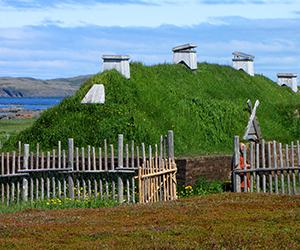CANADA HISTORY - War-New France
Background

n 1689, the long-running conflict between Britain and France, often referred to as the Second Hundred Years’ War, began anew. The outbreak of the War of the League of Augsburg, known in the American colonies as King William’s War, was part of this greater struggle. What began as a European war quickly spilled over into North America, igniting a fierce rivalry between the French and English colonists. This colonial conflict was fueled not only by imperial ambitions but also by deeply rooted religious animosities—on one side, the Puritans of New England, and on the other, the Roman Catholic settlers of New France. These tensions heightened the brutality and ferocity of the fighting on the distant shores of North America, where both empires sought to claim dominance over vast, untamed lands.
At the heart of New France’s defense in this critical period stood Count Louis de Buade de Frontenac, an aging but still formidable governor whose name would become synonymous with the resilient defense of the French colony. Frontenac, at 69 years old, had returned to the governorship of New France in 1689, a position he had previously held from 1672 to 1682. His return could not have come at a more opportune time for the struggling colony. With decades of military experience and a reputation as one of France’s most capable colonial leaders, Frontenac was precisely the kind of figure needed to steer New France through its most perilous hour. The colony, though rich in natural resources and strategically positioned, was in dire need of strong leadership to face the threats looming from both English colonial expansion and Indigenous hostilities.
Frontenac wasted no time in taking the initiative. During the harsh winter of 1689-90, he organized and dispatched three war parties deep into English-held territories, launching attacks against the frontier settlements of New England and New York. These raids were as much psychological warfare as they were tactical strikes. The swift, brutal attacks on isolated English outposts not only caused significant casualties but also spread terror throughout the English colonies, goading them into action. These French raids, which would become notorious in the annals of New England history, demonstrated the offensive capability of New France, even when faced with vastly superior numbers.
The retaliatory response from the English colonies was swift and grand in ambition. By 1690, the colonial leaders of New England and New York, incensed by the French raids, came together to plan a decisive strike aimed at wiping out the French presence in North America once and for all. Their target: the fortified city of Quebec, the heart of French power in the New World. This was no small undertaking. The English colonies, despite their much larger populations and greater wealth compared to New France, were plagued by internal divisions. The colonies were not united under a single banner but were rather a loose confederation of competing interests, each with its own grievances and rivalries. Yet, despite these divisions, the sense of shared danger from the French and the potential reward of removing them from the continent spurred the English into action.
The military plan devised by the English colonies for the campaign of 1690 mirrored the strategy that would prove successful decades later during the Seven Years' War. The goal was to launch a two-pronged assault on New France. The first attack would come overland, with a land expedition advancing up the Hudson River and Lake Champlain to strike at Montreal, the second most important city of New France. Meanwhile, a seaborne force would sail up the St. Lawrence River to attack Quebec, the crown jewel of the French empire in North America. The plan was ambitious, and if successful, it would have crippled New France by striking at both of its key urban centers simultaneously.
However, while the strategy was sound, the execution of the plan fell short due to the limited military resources of the English colonies. Unlike the well-established professional armies of Europe, the colonial forces were largely made up of militia units—farmers, merchants, and tradesmen hastily assembled into fighting forces. These men lacked the training, discipline, and experience necessary for such a complex operation. The difficulties of mobilizing and coordinating these forces across vast distances, coupled with the disunity among the colonies, severely undermined the effectiveness of the campaign.
The naval assault on Quebec was entrusted to Sir William Phips, a man who, though celebrated in Massachusetts, had little in the way of military credentials. Phips’ reputation rested primarily on his success in salvaging treasure from a wrecked Spanish galleon off the coast of Hispaniola, an achievement that had earned him knighthood and local fame. But salvaging gold from the sea was a far cry from conducting a large-scale amphibious assault against a fortified city. Phips, described as a “rude sailor,” lacked the formal military training and strategic acumen necessary for such a demanding operation. He had never commanded troops in battle, let alone led an assault on a heavily defended stronghold like Quebec.
Despite his inexperience, Phips was given command of the seaborne expedition. He set sail with a fleet of ships and a substantial force of colonial militia, filled with the hope that the French would be quickly overwhelmed. The English plan, however, underestimated the formidable defenses of Quebec, as well as the strategic genius of Frontenac, who was more than prepared for the challenge. The events that would follow—the siege of Quebec and the legendary exchange between Phips and Frontenac—would become one of the most dramatic episodes in the early history of Canada. The failure of Phips' expedition to seize Quebec demonstrated that while the English colonies possessed greater numbers and resources, the resilience, leadership, and military preparedness of New France, embodied by Frontenac, allowed it to withstand these early assaults and maintain its foothold in North America for decades to come.
This moment in 1690 set the stage for a series of conflicts that would rage between the two colonial powers for the next century. The struggle for dominance in North America, driven by the broader imperial rivalry between France and Britain, would ultimately reshape the continent. Although the English colonies would continue to grow in strength and population, their inability to coordinate effectively against the French during this early period highlighted the challenges they faced in asserting control over the vast, contested territories of the New World. It would not be until much later, with the backing of a full Royal Navy and British regular forces, that New France would fall, not to the colonial militias of New England, but to the might of the British Empire itself.
Cite Article : Reference: www.canadahistory.com/sections/documents/documents.html
Source: NA



